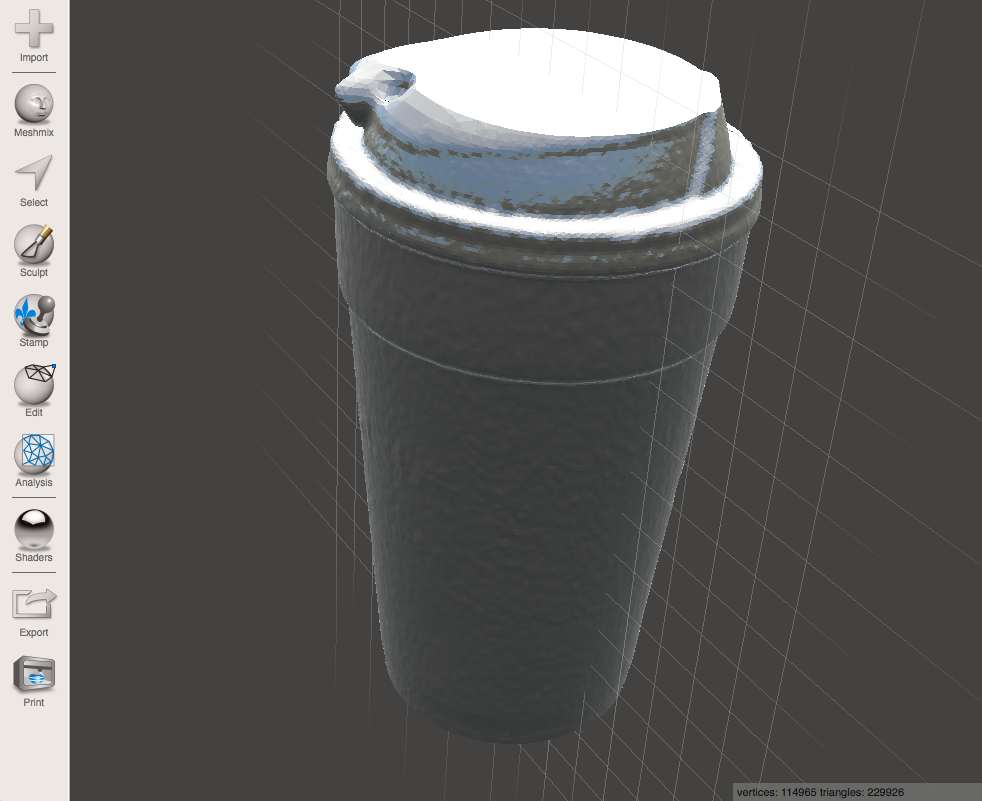
Design and make a 3D mold (~ft2), and produce a fiber composite part in it.
For this project, I decided to two two things....
My goals for doing this this way were...
| For the second half of this assignment,
I used a scan of a Dunkin Donuts coffee mug. I
attempted to cleanup parts of the model in Meshmixer
(pictured on the right). Here are the files that were
used to mill the object into insulation foam on the 2Bot. |
 |
Preparation start, I laid out the
materials, which were:
|
|
Fiberglassing and DryingGiven this was the first time I'd done this, I was amazed at how easy it was to get the fiberglass to soak in the resin and to get it all adhering to the wood.Learning: Prep matters As I was doing this, I wasn't too worried about how precise everything laid out. This was partially because my dad, who was hanging out and helping, said I should worry about it given you could sand it all down. Well, he was right (sort of). By and large, there were a few small bubbles that appeared, and yes, we were able to sand them down. The more problematic areas were the ends where there were sharp edges. In these places, the fiberglass mesh splintered a bit. The other thing we didn't do was to pre-cut the H in the center. Theory was that it would be easy to cut out...and it was easy. BUT, it didn't look that good after everything dried and we cut it. This was partially because it was an area that was hard to sand. So, in retrospect, I should have spent more time cutting and shaping the fiberglass so that it fit perfectly over the wood. |
|
Final outcome |
PreperationFor this round, I changed a few things around:
Here were the materials as they were laid out... |
|
FiberglassingI wrapped the loose fiberglass around the perimeter. I put in pins to hold it in place while I applied the initial fiberglass. It went ok. You can see the right half of the mug has the fiberglass applied (and the left is still just the loose fiberglass). It was surprising how well the resin matted down the fiberglass having said that: |
Object after initial resin applied Entire object after all resin applied |
Final Outcome and LearningsThe final outcome was not pretty. But to be honest, I didn't expect it. I wanted to learn and try different things. Namely, I wanted to see how the foam insulation would handle the fiberglass.Learning: Don't use the foam I knew fiberglass got hot when it cured. And I knew the insulation might not handle it well. Well now I have proof. If you look closely, you'll notice that the hole in the fiberglass shows the burned / melted insulation. In fact, about a half a centimeter of the entire coffee mug melted away leaving the fiberglass in tact. Learning: Use the best fiberglass material possible Having tried both the loose fiberglass and the sheets, it was clear that the loose fiberglass was harder to get right. As an example, the image on the right shows how the loose fiberglass could dry with pieces sticking out. Yes, you can sand this down and yes I could have done a slightly better job of matting it down when applying the resin, but it was clear that the loose material was harder to consistently apply as it splintered and got quite messy quickly. Learning: Use smaller pieces As I did this, I realized I should have done smaller bands rather than one really big one around the base. The smaller bands would have minimized the excess that ended up draping down. If you checkout the final result, you can see how the resin/fiberglass became bunched at the bottom. I think next time I am going to try this with the vacuum bag to see how well the sides adhere to the object. |
Final Result
Learning: Foam melts when fiberglass
gets
hot
Learning: Loose Fiberglass
|